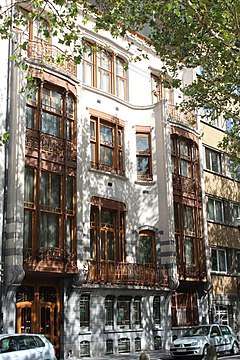Art Nouveau in Brussels
|
Stairway in the Hôtel Tassel by Victor Horta (1894) | |
| Years active | 1890–1910 |
|---|---|
| Country | Belgium |
Art Nouveau is an artistic movement of the late 19th and early 20th centuries, which arose from a reaction against the European academic art of the 19th century. It is based on the aesthetics of curved lines, inspired by natural shapes and structures. It has a particular cultural resonance in Brussels, where the leading art nouveau architect Victor Horta was based.
History
The Hôtel Tassel is often regarded as the first architectural work in Art Nouveau style in Brussels. This building, dating from 1893, was a creation of Horta and his architectural style was soon emulated by his colleagues. Some of Brussels' municipalities, such as Schaerbeek, Etterbeek, Ixelles, and Saint-Gilles, were developed during the heyday of Art Nouveau and have a large number of buildings in that style.[1][2]
In spite of the many demolitions between the end of the Second World War and the late 1960s, Brussels still counts more than 500 buildings in Art Nouveau style.
Town mansions
The style of Horta was very popular with the upper middle class, who commissioned many mansions, such as the Hôtel Frison (1894), the Hôtel Winssinger (1894–1897), the Hôtel van Eetvelde (1895), the Hôtel Deprez-Van de Velde (1895–1896), and the Hôtel Solvay (1898).
In addition to these grand mansions, there were more modest residences such as the house-studio of the sculptor Fernand Dubois (1901–1903), the Sander Pierron House (1903), not to mention Horta's personal home (1898–1901).
Stores and department stores
The style was also used for the retail sector, for example the Waucquez store (1906) (now housing the Belgian Comic Strip Center) and the Wolfers brothers store (1909), as well as department stores, such as the Old England department store (1898–1899), the Innovation (1900) and the Grand Bazaar Anspach (1903).

 Wolfers brothers store
Wolfers brothers store Old England department store
Old England department store
Protection status
Among the Brussels-style Art Nouveau creations, four buildings by Victor Horta were added to the UNESCO World Heritage List in 2000 under the title "Major Town Houses of the Architect Victor Horta (Brussels)": the Hôtel Tassel, the Hôtel Solvay, the Hôtel van Eetvelde and the Horta House (currently the Horta Museum).[3]
The Stoclet Palace, built between 1905 and 1911 by the Austrian architect Josef Hoffmann, one of the founders of the Viennese Secession, has also been listed as a World Heritage Site since 2009.[4]
References
- ↑ "10 must-visit world-class Art Nouveau buildings in Brussels!". visit.brussels. Retrieved 25 August 2018.
- ↑ Stambolic, Ana. "The Most Remarkable Art Nouveau Houses In Brussels". Culture Trip. Retrieved 25 August 2018.
- ↑ "Major Town Houses of the Architect Victor Horta (Brussels)". whc.unesco.org. UNESCO World Heritage Centre. Retrieved 25 August 2018.
- ↑ "Stoclet House". whc.unesco.org. UNESCO World Heritage Centre. Retrieved 8 January 2017.


